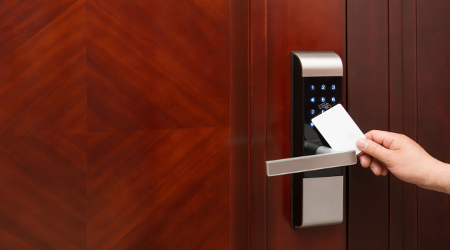 Security has become a top priority within commercial and institutional facilities and managers need to understand the latest advances in door hardware designed to enhance the safety of facility occupants and visitors.
Security has become a top priority within commercial and institutional facilities and managers need to understand the latest advances in door hardware designed to enhance the safety of facility occupants and visitors. Door Hardware: Making Facilities Secure
Managers who understand facility needs can make better decisions to specify the proper door hardware equipment and help keep their facility secure.
The evolution of door hardware is, in part, a result of changes to increasingly complex facility security systems.
“The drive for these changes is the heightened awareness of the need for security in the world today,” says Chris Orme with Select Hinges. In recent years, door hardware equipment has seen advances related to electronic access control, including keypads, card readers, biometrics, through-wire hinges, mag-locks, and electric strikes. Physical security needs — including forced-entry rated hardware, continuous hinges and locks and changes in the functions of locking hardware — also are driving the evolution.
“Years ago, we saw mostly mechanical products throughout various facilities,” says Paul Bilyeu with Allegion. “Nowadays, I think we’re starting to see a mixture of mechanical products where security is maybe not as big of a concern. Or in certain areas, they are adding access controls with electronic locks.”
Door hardware manufacturers also are responding to the growing availability of wireless technology in facilities.“Wireless technologies have enabled facilities to deploy and expand access control in places that it had not been previously available or financially viable,” Gaughan says. “This expansion of electronic access helps reduce the complexity in key system maintenance and demands on the key shop.
“It creates greater opportunity for facilities utilization (because) access to different buildings and areas can be managed with rights and schedules, allowing for larger user populations.”
Another big advancement in door hardware equipment is intelligent keys, which offer authorized access control but also leave a digital signature of who used the door and when. These audit trails become important in helping to maintain security throughout a facility.
“By putting a chip into the key bow, you can download access rights onto a key that can communicate with the cylinder in the door lock,” Agans says. “This is really a great advancement for retail environments where stop loss is a big factor.”
Wireless advances also enable managers to focus their security efforts on a small number of entrances instead of entire facilities.
“With the advent of wireless technology, door hardware manufacturers are coming up with more solutions to fit an end user’s needs,” Agans says. “Small business will certainly benefit by these technology changes, as they will find it easier to employ small access control systems into their facilities.
“In the past, there have been few solutions for the end user who wants to control just a few doors. Today that is no longer the case.”
Know what you’re buying
Advances in door hardware bring benefits to facilities, but they also raise the stakes for managers looking for the most appropriate products.
“I think that to some of the causal observers, they think of door hardware as being simple, and it’s really not,” Bilyeu says. “Once you start peeling that onion back, it becomes very complicated very quickly. Products are very application specific in how you want them to act. Locks, exit devices, and closers may all look the same on the outside, but they can act 30 different ways on the inside.”
Because managers have an array of choices when it comes to door hardware, it is important to get all of the facts before making a purchasing decision. In some cases, managers might need additional guidance in the process.
“My advice is that you seek out industry professionals to help you develop and employ your door hardware, regardless if it has wires, batteries, radios or just that good old physical key,” Agans says. “The Door and Hardware Institute can provide you with a list of credentialed door hardware professionals in your area. Find them, and let them help you develop a plan to implement the right hardware and access control for your facility.”
Related Topics:













